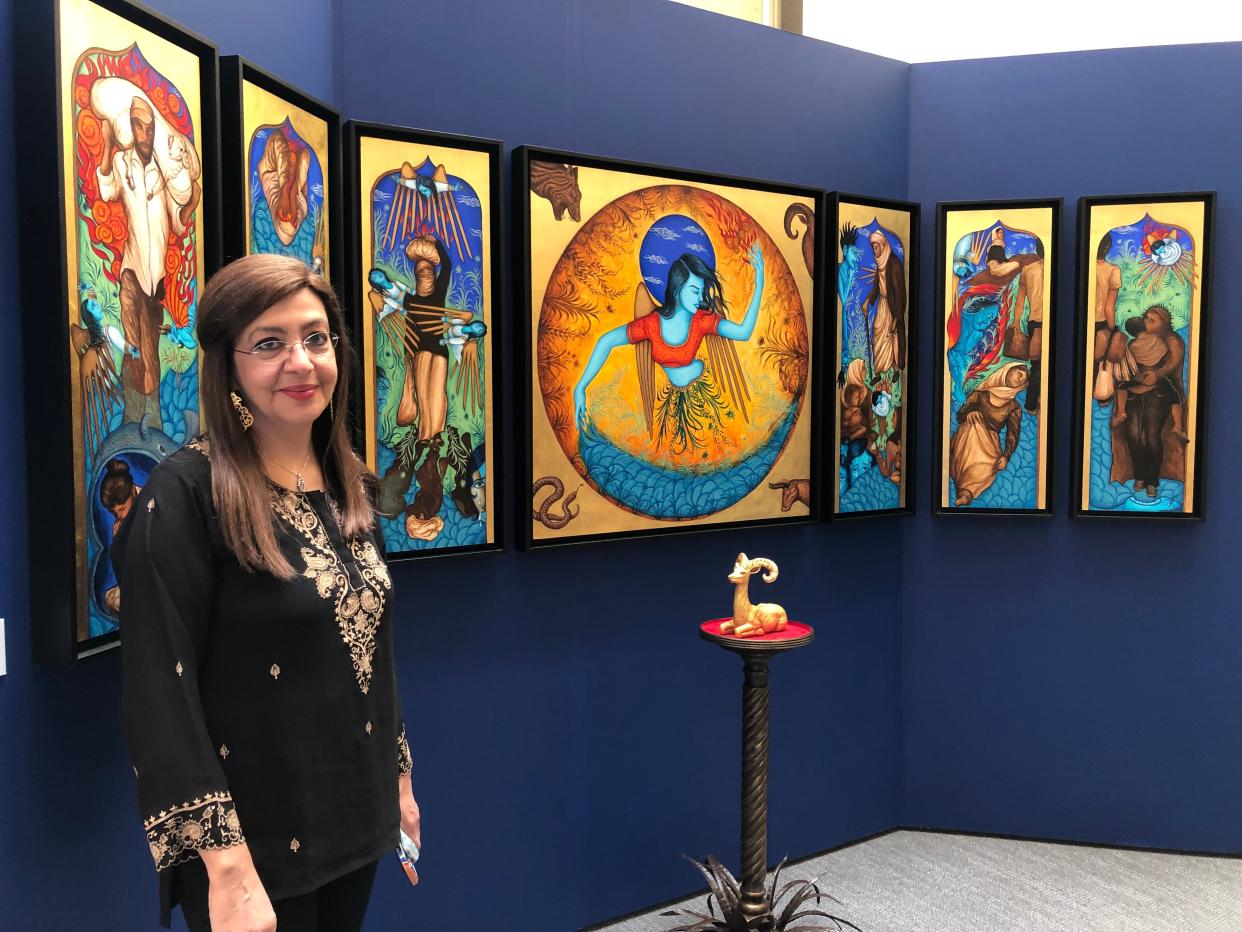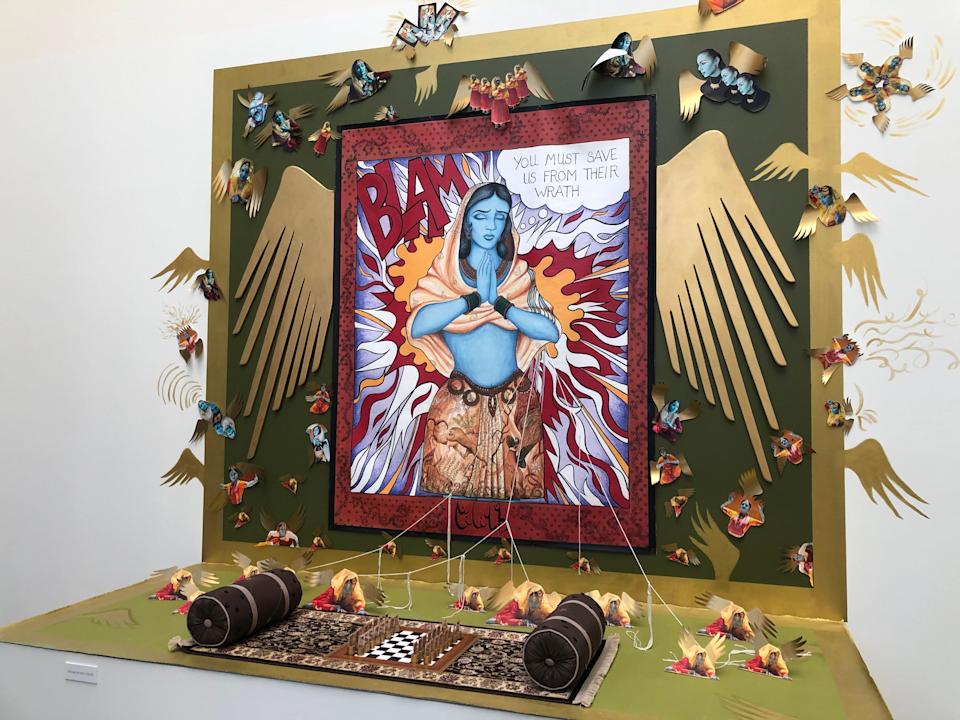'Beyond Borders' exhibit at Jewish Museum transcends culture, explores social justice issues

- Oops!Something went wrong.Please try again later.
Siona Benjamin is a Jewish multimedia artist who was born in India, raised in a majority-Hindu and Muslim community, attended Catholic and Zoroastrian schools, and now lives in New Jersey. Fittingly, she calls herself a "transcultural artist."
Influenced by the many cultures that have touched her life, Benjamin's new exhibit at Jewish Museum Milwaukee explores themes of multiculturalism, identity and social justice issues like immigration, feminism and the global refugee crisis.
Combining elements of Indian and Persian miniature painting traditions, Hebrew illuminated manuscripts, Renaissance-inspired Catholic symbology, and reimagined depictions of biblical figures and Hindu gods, Benjamin seeks to unite diverse viewers through her work.
The exhibit, aptly titled "Beyond Borders: The Art of Siona Benjamin," is on display at the Jewish Museum through Sept. 25. Special events, film screenings and lectures featuring Benjamin or addressing the themes of her work will take place throughout the duration of the exhibit.
"It's the many parts of me that I want to talk about, not just being Jewish or being Indian or American," Benjamin said of her work. "I don't want to just be a Jewish artist or Indian artist ... I want to be a contemporary artist."
She believes creating art inspired by many cultures is especially important in today's increasingly divided world.
"Being a transcultural artist is a method to talk about ... bridging many cultures or being able to show the similarities, not the differences," she explained. "When you show the differences, that's what causes war and violence. When you show the similarities, you show that we are, as a people, all human beings."
A woman of many cultures
Benjamin was born into Mumbai's Bene Israel community, a small Jewish community in India's second-most populous city. She described Jews in India as a "micro-minority" that, at its height, only had about 30,000 members in a country of over 1.3 billion people.
Benjamin's parents were educators and exposed her to "a revolving door of different viewpoints, different religions and different cultures," she said. However, the greatest gift her parents gave her was an art box that allowed the only child to discover her love of drawing, painting and art history at a young age.
When she was 23, Benjamin immigrated to the U.S. to pursue a master's in painting at Southern Illinois University. According to Jewish Museum Milwaukee curator Molly Dubin, Benjamin's experiences as an immigrant inspired her to explore themes of exclusion, otherness and multiculturalism in her work.

One work in which Benjamin confronts these topics is her 2016 seven-panel painting "Exodus: I See Myself in You."
Benjamin explained the piece is intended to be a social commentary on immigration and the refugee crisis. The panels include images of tired refugees fleeing with their children and animals, a woman in the mouth of a whale and another woman crying out in agony.
These human figures are surrounded by blue angels and demons, which Benjamin said represent "the ying and yang of life." The piece's center panel represents the Garden of Eden, while the six outer panels depict refugees attempting to enter the paradise, she said.
"The angels are helping them, and the demons are stopping them. It's like in life," she said. "Some people are the demons that stop things from happening. Some people are the angels that help things happen."
In addition to the Garden of Eden and the whale — a reference to the Biblical story of the prophet Jonah — Benjamin includes religious symbolism in the arrangement of the piece. She said the large middle panel with an equal number of smaller panels on either side is meant to subtly resemble a menorah, which has one larger candle in the middle surrounded by four smaller candles on each side.
"I like the subtle things," Benjamin said. "Like I'm not going to paint a menorah ... that's just hitting you over the head with it."
Modernizing traditional stories

Much of Benjamin's work also incorporates themes of feminism. She said growing up in a largely patriarchal Muslim and Hindu community inspired her to explore feminism in her art and reimagine traditional female figures through a modern and empowered lens.
One of Benjamin's largest pieces in the Jewish Museum exhibit — a multi-dimensional mixed-media installation titled "Lilith in the New World" — reimagines the Old Testament figure Lilith as a modern woman.
"In biblical history, Lilith was Adam's first wife, but she was cast out of the Garden of Eden. Why? Because she refused to be subservient to Adam," Benjamin explained. "She wanted to be equal to Adam. She is kind of the original feminist."
Although Lilith has generally been viewed as an evil or even demonic figure throughout history, in the mid-20th century, she became a symbol of feminist movements, Dubin said.
Benjamin's Lilith was also inspired by the Indian cartoons she enjoyed as a child and the pop art style of American mid-century artists like Roy Lichtenstein. But while Lichtenstein's paintings depict women crying, gazing in the mirror and longingly daydreaming about men, Benjamin's pop art seeks to replace these images of "damsels in distress" with ones of power and independence.
For Benjamin, the color she made Lilith's skin — blue — is particularly significant. It is the color of many Hindu deities.
"Having grown up surrounded by these religions that are largely patriarchal ... it adds another layer," Dubin said. "In painting the women blue in her pictures, (Benjamin is) asking the viewers to reconsider what they think they know or perceive about gender roles."
Inspiring important conversations
Dubin said the themes of Benjamin's work closely reflect the Jewish Museum's mission of social justice. She wants the exhibit's multicultural and historical influences to serve as key points of discussion among museum visitors.
"I hope it can be a springboard for encouraging conversation across borders," she said. "We look to create bridges between the past and the present to demonstrate where there may be historical origins for contemporary issues."
Dubin also hopes the transcultural nature of Benjamin's work attracts new visitors to the Jewish Museum including members of the South Asian and other religious communities.
"There's something that speaks to everyone and maybe opens up their minds a little bit, opens up their horizon or at least gets them thinking in that direction," Dubin said. "There are so many more layers, so much more complexity, than what we think we know or what we think we understand, and (Benjamin) just shows it so eloquently."
If you go
What: "Beyond Borders: The Art of Siona Benjamin."
Where: Jewish Museum Milwaukee, 1360 N. Prospect Ave.
When: Monday - Thursday 10 a.m. - 5 p.m., Friday 10 a.m. - 3 p.m., Sunday noon - 4 p.m., through Sept. 25.
Our subscribers make this reporting possible. Please consider supporting local journalism by subscribing to the Journal Sentinel at jsonline.com/deal.
DOWNLOAD THE APP: Get the latest news, sports and more
This article originally appeared on Milwaukee Journal Sentinel: Jewish Museum Milwaukee exhibit explores global, social justice issues

